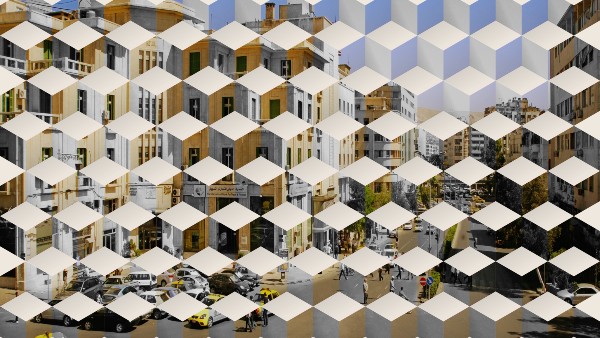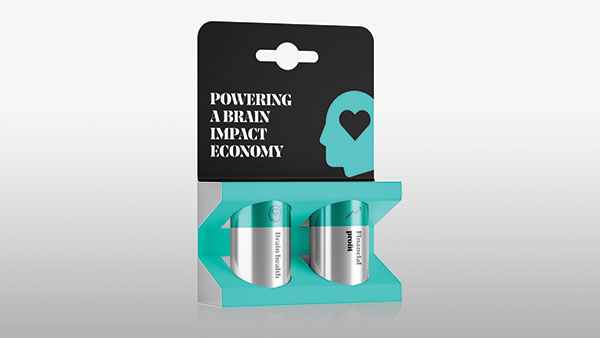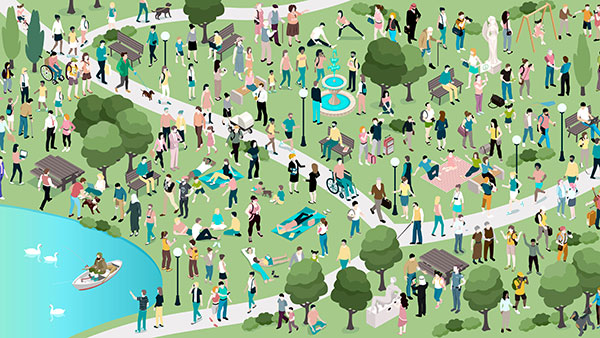The RSA has developed a new framework to ensure its research and innovation have greater impact.
We design at our best in times of uncertainty, urgency and crisis. As the American architect and educator Ann M Pendleton-Jullian puts it: “Design for emergence is designing for change in a context or system already in motion.” An unprecedented pandemic. The worst global economic recession since the Great Depression. Systemic racism, long at untenable levels, coming to another historical boiling point. Growing polarisation and conflict. An alarming increase in wildfires across five continents. An unprecedented violent assault on the world’s oldest democracy. Two decades ago, innovators, futurists and visionaries looked ahead to the 2020s as a suitably distant and futuristic-sounding decade on which to project ideas about what ‘good’ might look like and what we might aspire to achieve. Ironically, as that decade drew closer, it grew more apocalyptic than aspirational.

The crises of the 2020s certainly did not begin with the start of the decade. Our current situation brings to mind for me the image of an iceberg. The challenges and conditions that led to our current crises are the layers of the iceberg deep below the surface: hidden, but able to be ignored while the visible structure above the water is stable. But all the while, the temperature has been rising, putting pressure on the entire edifice, which has become weakened and more susceptible to a sudden outside event; in this case, the Covid-19 pandemic. This shock has revealed the deep structural challenges below the surface. I envisage that layers will continue to be exposed over the next decade, triggering more crises along the way. Unless, that is, we take radical action to find a balanced way of living where people and planet can thrive in harmony.
A time for change
Last year gave us all the signals we need to know that now is the time to actively question whether the old normal – designed through habits, values and systems for living, working, making and trading, and how these all intersect with one another – is healthy and sustainable for the long term.
Over the past year, we have seen communities and organisations come together to embrace the uncertainty of this time as an opportunity for innovation, experimentation and renewal towards a better future. The value of social capital came to life overnight as neighbourhoods all over the UK formed mutual aid groups to care for the most vulnerable. Within a week of the first UK lockdown, my own local group for our estate had identified champions, designed a support service, created an open toolkit of resources and information using free collaboration platform Trello, and leafleted all 2,000 houses offering and asking for support. Nearly a year later, the relationships formed through these groups are already delivering value to community members and are here to stay through the pandemic and beyond, strengthening community resilience.
Meanwhile, parts of the public sector that could deliver their services remotely shifted their operations to digital first as soon as they were able to. GP practices are tapping into a national network of GPs beyond the capacity of their local practice in order to be more responsive when offering callback appointments. They are also using WhatsApp for visual diagnosis of symptoms, making healthcare more convenient for patients and practitioners alike by enabling them to bypass the need to download another health app. For many public services, such as primary healthcare, digital first had been an ambition for many years in order to increase accessibility, reduce cost and maximise the capacity of the workforce, with the pandemic finally creating the urgency needed to make this shift within days.
Catering and food production services pivoted their business models with little notice, from business-to-business to business-to-consumer in response to lockdown. Food sourcing company Natoora is only one of many examples, shifting from supplying food to chefs to re-imagining food supply across the entire system: from farming to retail and consumers, and towards food waste elimination. Opening up to wider markets has diversified these businesses’ revenue streams, enabling them to be more responsive in the long term as new challenges and crises emerge.
As my colleague at the RSA Ian Burbidge reflected recently: “These communities saw the needs presenting in front of them and they did something. And as those needs have changed, so has their work. They didn’t standardise, they absorbed variety. They reacted to emergence, they didn’t excessively plan and follow fixed delivery models. As opportunities presented themselves, so they responded. They were able to see what works and what doesn’t, and amplify the former and move on from the latter.” These communities were Living Change.
The Living Change Approach
This is what we mean at the RSA when we talk about Living Change. We need to see more communities of change recognising that the challenges we are facing are simply too complex and intractable for a single discipline or organisation in the system to address in isolation. With the Living Change Approach, the whole is greater than the sum of its parts.
Living Change is being applied to all of the RSA’s programme work in order to have a positive impact on individuals, communities, society and the planet. The approach challenges us to think like a system as we strive to understand and define the challenges we are experiencing (the ‘what is’), and to act like an entrepreneur as we innovate and experiment with interventions that shape inclusive, equitable and sustainable futures (the ‘what if’). We need to see the whole system as a complex web of interconnected social events, trends, structures, models and players.
For example, the pandemic has hit minority ethnic groups the hardest because many of them are low-paid key workers risking their lives on the frontline, and because these groups have higher rates of underlying health conditions. Both of these factors are driven by an inequitable social, economic and political system that hinders the ability of these groups to access and negotiate better-paid work and to achieve the living and working conditions that are essential for good physical and mental health. Thinking like a system about these root causes and interdependencies is the first step in achieving a real understanding of what is driving the challenges we face today and where there might be energy for change.
We also need to approach change in a way that allows us to experiment entrepreneurially with multiple interventions that alter different nodes and relationships in the system, to learn quickly, to adjust our approach when things do not work and to accelerate when they do. We might, for example, bring together at-risk communities with local authorities, governmental bodies and civil society leaders to design interventions that improve their living and working conditions, while advocating for equal health, work and pay opportunities and, at the same time, designing temporary protective factors around these groups until long-term interventions start to take effect.
We have been applying, iterating and improving the Living Change Approach across a range of systemic challenges. With Cities of Learning, we are using the approach to disrupt the future of learning in cities through digital innovation, movement building and place-based models. This widens access to learning opportunities – based on core life skills – for all ages.
In our Make Fashion Circular project, we sought to understand the systemic challenges standing in the way of circular practices in the fashion industry and to identify an opportunity for tapping into the energy, and developing the capabilities, of creators and innovators across the system to accelerate the transition to a circular future for fashion. This has led to the recent launch of our Rethink Fashion learning journey, a collaboration between the RSA and the Ellen MacArthur Foundation, with support from the People’s Postcode Lottery Dream Fund. A hosting team and 12 creatives are participating in this journey, bringing together various perspectives and experiences from across the fashion system. In 2020 Crises and Change, we are gathering and amplifying stories and aspirations from communities in the UK about response, recovery and renewal during and beyond recent crises, with the aim of inspiring communities around the world to re-imagine their future for the long term.
Design for social innovation is at the core of the Living Change Approach, but it cannot act alone. The Approach draws on a diverse range of other established and emergent disciplines such as critical thinking, social research, systems thinking, entrepreneurship, and futures and foresight. The Living Change Approach is not new; what is new is how it brings these disciplines together in a collaborative way to design and deliver effective interventions. But why design for social innovation?
We are all designers
“All that we do, almost all the time, is design, for design is basic to all human activity. The planning and patterning of any act toward a desired, foreseeable end constitutes the design process. Any attempt to separate design, to make it a thing-by-itself, works counter to the fact that design is the primary underlying matrix of life.” These are just some of the words written by the Austrian-American designer and educator, Victor Papanek, that I tend to turn to in my work. Although working in the mid to late 20th century, Papanek was one of the earliest thinkers to realise the inclusive nature of design as an everyday practice basic to all human activity. There is power in this realisation when all of us – as everyday designers – consciously apply this practice in order to intentionally improve the world we live in.
Design is all around us, and most of us have had an active role in it even if we may not recognise that. Wherever we are, we all design norms and habits in the way we choose to live and work and how that influences those around us. Whatever industry we work in, we all design practices, products and services that shape our current and future society, economy and ecology in some way; negatively or positively, intentionally or not. Whomever we advocate for, we all design power dynamics that may give more influence and opportunity to some over others.
It is human nature to design for need, to design for better, to design for change. Our designer mindset – whether we identify as designers or not – sees challenge as opportunity not obstacle; learns through imagining, making, testing and iterating, not predicting; embraces ambiguity as space for creativity not anxiety; approaches novelty with curiosity not fear; and explores diversity with empathy not judgement.
Developing conscientious design
However, despite some of its virtues, design – as a professional practice – has been far from a hero. For the past century, when ‘design’ as a mindset started finding its voice, language and industry as a discipline, it has failed to recognise its power and impact, and therefore its responsibility. It has contributed to a lot of the social challenges in our world leading up to this decade. Design has been more biased than equitable, focusing on serving and servicing communities of privilege who have the resources to invest in it as a professional practice. Design has sided with short-termism over long-termism, offering us all the quick fixes and gadgets we need to solve our day-to-day problems, with little accountability or thought for long-term consequence. Design has focused on individualism over collectivism, putting consumer spending before community wellbeing. Design has put people over planet, assuming infinite socioeconomic growth while exploiting the earth’s finite resources.
More optimistically, however, it is evident that conscientious design movements, such as design activism, social design and sustainable design, are on the rise. In 1964, designer Ken Garland published the First Things First manifesto, with backing from over 400 designers, affirming that design is not a neutral and value-free process, and that designers have responsibility and accountability of choice to prioritise work that delivers humanistic outcomes before consumerist outcomes. Since 1989, Adbusters has been leading an activist movement of designers, artists and other creatives speaking up against activities that benefit corporate interests to the detriment of public and environmental interests.
In 2008, the UK government issued a Code of Practice on Consultation, requiring all government bodies to consult with members of the public and stakeholders likely to be affected prior to any changes to policy. The code created an opportunity space in which human-centred designers could explore different approaches aimed at engaging
and involving the public and stakeholders in co-designing the future of public services. The UK Government’s Policy Lab is an example of a team of designers working closely with policymakers to develop new tools that place people and data at the heart of new policies.
In 2013, the Public Services (Social Value) Act came into force in the UK, requiring public service commissioners to think about wider social, economic and environmental benefits and the consequences of their commissioned services. This provided an incentive for all private and third sector organisations working with public sector commissioners to deeply explore how they can better deliver social impact through the services they are designing and delivering. Finally, we have seen an increasing number of higher education bodies design and accredit courses that aim to help designers and innovators to develop their skills in a way that centres social and environmental impact at every step. Although highly encouraging, some of the movements and seismic shifts listed here have certainly been the margin, not the mainstream.
Design for social innovation
Cue in social innovation and the value this practice, as pioneered by British sociologist Michael Young, has on developing effective solutions to challenging systemic social and environmental issues. Social innovation at its best recognises that its work often requires active collaboration across different sectors and levels of the system to effect meaningful social change.
Alongside systemic collaboration, the power of social innovation lies in its ability to bring together four different paradigms – society, technology, economy and ecology – to identify opportunities and to create or amplify interventions that are either new, or new to a particular context, in order to tackle complex challenges.
The society paradigm is about understanding the needs and strengths of our collective society, now and in the future. The technology paradigm is about recognising the art of the possible when 21st-century tools, ways of working and organising are put to use to address our social and environmental challenges. The economy paradigm is about exploring, interrogating and disrupting the ways in which materials, goods and services are produced, traded, managed, used and valued. The ecological paradigm is about striking balance and harmony between our society’s need for resources to thrive and our ecosystem’s need for regeneration so it can thrive with us.
The four social innovation paradigms, brought together with a designer’s mindset, create an exciting opportunity for design for social innovation: a practice that is open, optimistic, pioneering and rigorous, and provides the support that enables us to both imagine and create a better future.
We know all too well, though, that design for social innovation is not the saviour here. It is simply one part of the puzzle.
Living Change for all
Historically, design for social innovation was seen as the work of professionals from the creativity, social change and policy spheres. Thinking and writing on the subject have always been loaded with jargon, as if jargon elevated the practice and as if the learning of the jargon offered a rite of passage into the profession. But Living Change needs to be everyone’s business if we are truly going to shift the needle on today’s intractable social challenges. The Living Change Approach is for everyone who is passionate about making social change happen. The professional, the citizen, the activist, the civil servant, the leader, the employee, the student. Regardless of role, we know we can have better impact when more of us come together around change.
Designing for Living Change goes beyond the jargon and the tools to encourage and enable a particular mindset for change: an openness to sharing, learning and collaborating; an optimism that looks out for positive opportunities amidst challenging times; a pioneering vantage point with bravery to explore and experiment with the new and unfamiliar; a rigorous outlook and willingness to do the work to understand the why behind the what; and an enabling ethos championing and supporting others on a change journey. Now, more than ever, we need people who can think systemically and act entrepreneurially.
As I write this, I am 100 days into my role as Director of Design and Innovation at the RSA. It certainly feels as if I have been here for longer; or rather, as if I have always been here. The pace of change, within the RSA and out there in the world, is fast, and there are also many opportunities to influence this change. I have joined this impact organisation during these uncertain times determined to create, enable and amplify movements of change that enable everyone to use design for social innovation in their change work. More specifically, I am eager to see what we can achieve through the RSA’s Living Change Approach as we unite people and ideas to address the most pressing challenges of our time.
We are now, for the first time, consolidating our legacy of Living Change insights, thought and practice from across our programmes into a playbook and a learning journey promoting this mindset, which will be made available to our Fellowship. We will share more on this soon. We know we cannot have all the answers, but we will continue to test and learn, openly sharing our experiences and inviting you to work with us to apply the Living Change Approach to the challenges of our time.
Thank you to Ian Burbidge, Rebecca Ford, Robbie Bates, Shirin Maani and Josie Warden for your contributions to the thinking shared in this piece.
Related articles
-
Unsteady foundations
Comment
Marwa Al-Sabouni
The importance of the built environment cannot be underestimated; it can make or break cities.
-
The brain economy
Comment
Harris A Eyre Anika Sinha Erin Smith Sandra B Chapman Alan Kirman Cara Altimus Marion Leboyer William Hynes
An economy based around psychological and cognitive wellness would enable us to create a stronger, more resilient future
-
Access all areas
Comment
Saba Salman FRSA
Policymakers need to pay more attention to the voices of those with disabilities




Be the first to write a comment
Comments
Please login to post a comment or reply
Don't have an account? Click here to register.